Davim J.P. Tribology for Engineers: A Practical Guide
Подождите немного. Документ загружается.


69
Lubrication and roughness
height R
a
. A commonly accepted illustration of the regimes
is the Stribeck curve (Fig. 3.1) which represents the
dependence of the friction coeffi cient on the so-called bearing
ratio
η
u/p
–
where
η
is the kinematic viscosity, u the velocity
of the moving part, and p
–
the mean pressure in the fl uid fi lm).
3.3.1 Hydrodynamic lubrication regime
The hydrodynamic lubrication regime, h>> R
a
, occurs when
the lubricant completely separates the surfaces (see Fig. 3.1);
it is mostly associated with fi lm thicknesses near or more
than 1
μ
m.
Friction losses under hydrodynamic lubrication are very
small – less than in the other lubrication regimes. The
hydrodynamic pressure generated in the lubricant fi lm due to
the relative motion and inner fi lm friction is too low to cause
surface deformation. The fl ow of the lubricant fi lm is laminar,
but at thicknesses above 20
μ
m it becomes turbulent and that
leads to undesirable friction losses.
Hydrodynamic lubrication
uu
u
hu
p
w
Stribeck curve and lubrication regimes
Figure 3.1

70
Tribology for Engineers
3.3.2 Boundary lubrication regime
The boundary regime, h< R
a
, occurs when the fl uid fi lm
is discontinuous and permits direct contact between high
points (known as asperities) of the opposite surfaces (Fig.
3.1). It is characterized by fi lm thicknesses less than 70 nm
and higher friction losses than under the other regimes.
Examples when this may occur are during equipment startup
or shutdown, when the bearing may operate in boundary
rather than in unbroken fl uid fi lm conditions, or in toothed
gear contact, or in reciprocating motion (e.g. car valve on
valve seat). In this mode the fi lm has less carrying capacity
than with contacted asperities.
3.3.3 Mixed lubrication regime
The mixed regime, h ~ R
a
, is transitional between the
boundary and hydrodynamic, when the fully-lubricated
(separated) and contacted (unseparated) surface areas
equally infl uence the friction and the fi lm parameters. Film
thicknesses range from above 70 nm to 1 μm (Fig. 3.1).
Friction losses vary over a wide range according to the two
limiting regimes involved.
3.3.4 Elastohydrodynamic lubrication
regime
The elastohydrodynamic (EHD) regime is a particular case
of the hydrodynamic with high hydrodynamic pressures,
suffi cient to impact one or two of the opposite surfaces.
The latter are separated, but there is some interaction
between the asperities, resulting in elastic deformation and
enlargement of the contactless area (Fig. 3.1), whereby the
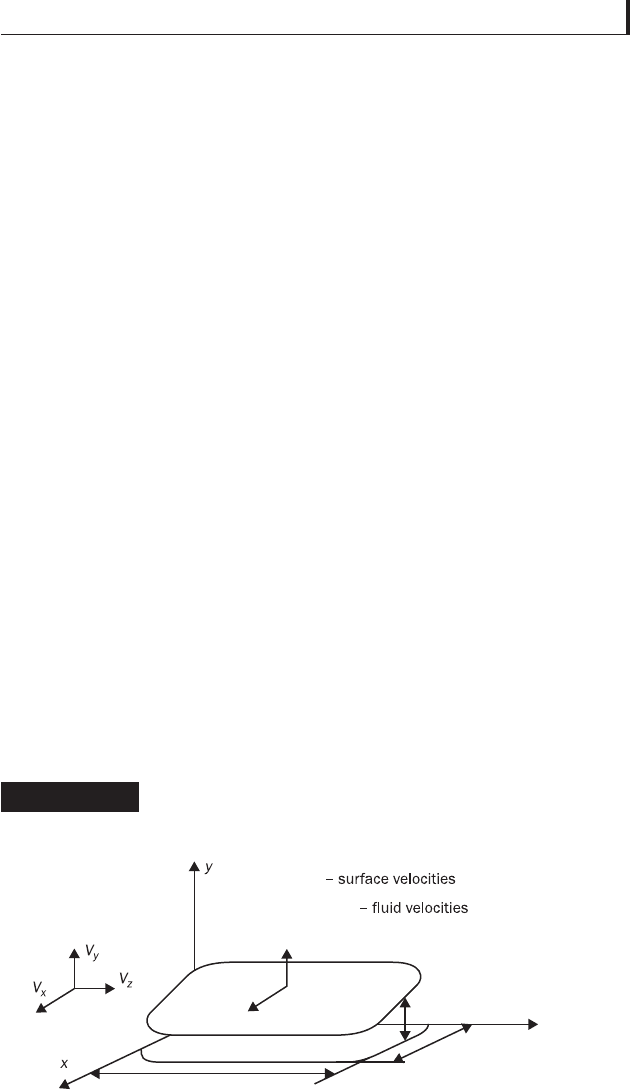
71
Lubrication and roughness
viscous resistance of the lubricant becomes capable of
supporting the load. Film thicknesses usually range from 10
to 70 nm; the minimal thickness is often connected to the
fi lm’s carrying capacity by the relation h
min
~ w
–0.073
. The
losses are the same as under hydrodynamic lubrication, as
the surfaces are completely separated. The main assumption
for the theoretical analysis is immediate elastic deformation
of the contacting materials and immediate increase of the
lubricant viscosity.
3.4 Reynolds’ equation
The fl ow of the lubricant obeys the classical hydrodynamic
theory with some simplifi cations specifi c to thin fl uids. The
surfaces, the fl uid fi lm thickness, and the fl uid- and moving-
surface velocities are shown schematically in Fig. 3.2. Here
we proceed to derive an expression that describes the
hydrodynamic pressure in lubrication, making use of the
momentum-transport (Navier-Stokes) and continuity
equation.
U, V
h(x,z,t)
V
U
V
x
, V
y
, V
z
h<<I
x
,L
z
L
x
L
z
z
Derivation scheme for Reynolds’ equation.
Surfaces, fl uid fi lm thickness, velocities and
coordinates
Figure 3.2
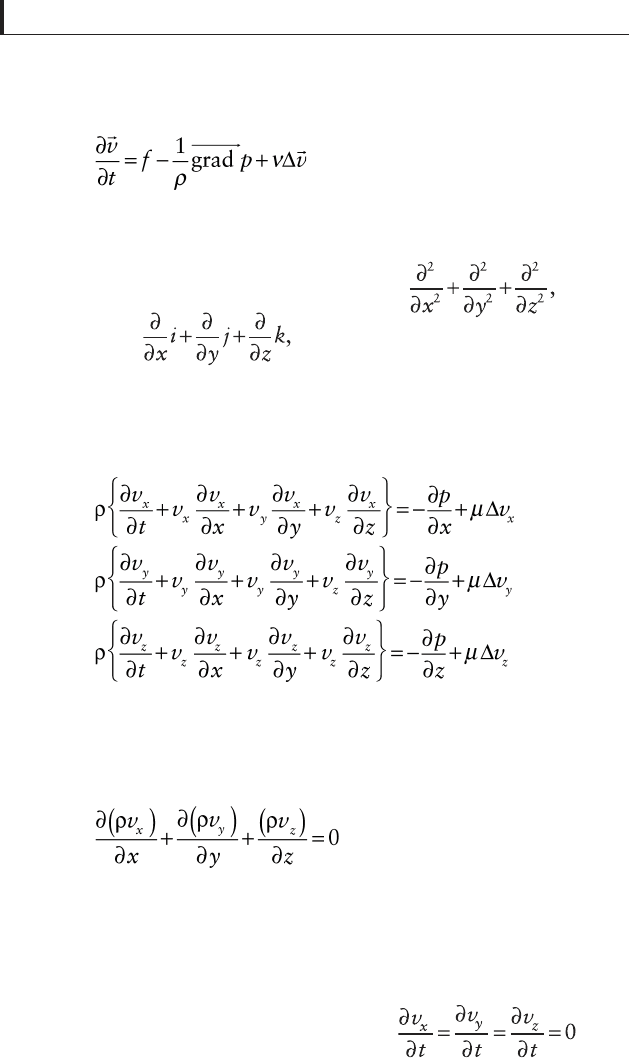
72
Tribology for Engineers
The fi rst of these in vector form reads:
[3.1]
where p is hydrodynamic pressure, v is fl ow velocity, t
is time, f are forces acting on the fl uid, ρ is fl uid density,
ν
is
kinematic viscosity, Δ is Lapltacian
grad is
gradient
and i, j, k are unit vectors of the x–,
y–, and z directions respectively.
For an incompressible, isoviscous Newtonian fl uid in laminar
fl ow, its components can be described in full format as:
[3.2]
where μ is the dynamic viscosity.
As regards the continuity equation, for laminar inertialess
fl ow it reads:
[3.3]
Because of the smallness of the gap-to-length ratio
(h/l) << 1 (the ratio of fi lm thickness to its length) the fl ow
terms of order (h/l)
2
and higher can be disregarded in the
eqs. [3.2], presented previously in dimensionless form. Thus,
eqs. [3.2], rewritten for inertialess
fl ow,
reduce to:
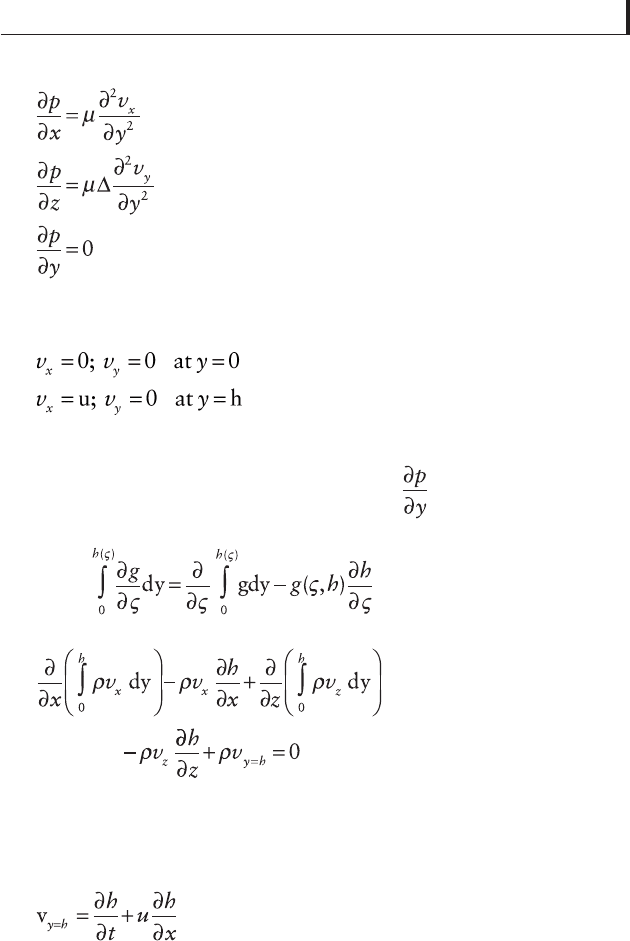
73
Lubrication and roughness
[3.4]
with the boundary conditions
[3.5]
Integrating the continuity equation with respect to y over the
thickness limits 0 . . . h (the pressure and
do not change
in that direction) and applying Leibnitz’s integration
formulae
, we obtain
[3.6]
Here the velocity v
y = h
is the total derivative, or in partial
form
[3.7]
Further, the integrals in eq. [3.6] represent the mass fl ow
rates (lube consumption) in the x and z directions. Substituting
the velocities (determined from eqs. [3.4]) and considering
the boundary conditions [3.5], we can obtain

74
Tribology for Engineers
[3.8]
Note now that
, the law of mass
conservation. Considering this in conjunction with eqs. [3.7]
and [3.8], eq. [3.6] transforms into the elliptical differential
equation obtained by Reynolds, named after him, and known
as the central expression of hydrodynamic lubrication theory:
[3.9]
The pressures on the left-hand side generate the fl ow through
their gradients; the right-hand terms represent the fl ow
generated by a possible shift in the y-direction (squeeze) and
by the moving- surface velocity u. The fl uid velocities
[3.10]
refl ect the superposition of two fl ow modes: the Poiseuille,
due to imposed pressure gradients; and the Couette, a shear-
driven effect due to motion of the upper surface. In the v
x
curve the Poiseuille fl ow is associated with a parabolic
velocity distribution across the fi lm, and the Couette fl ow
with a linear one.
Solution of Reynolds’ equation yields the hydrodynamic
pressure distribution which in turn, combined with eqs.
[3.10], yields the fi lm’s load capacity
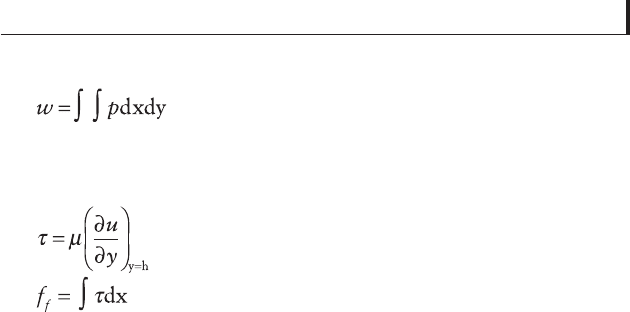
75
Lubrication and roughness
[3.11]
as well as the shear stress and the friction force at the
lubricant-surface contact:
[3.12]
Solution of Reynolds’ equation involves boundary conditions
specifi c to each practical case. How this is done is shown
in the subsequent sections, on the examples of slider and
cylindrical journal bearings.
3.5 Applications of hydrodynamic
lubrication theory
In view of its key role in the pressure distribution
determination, Reynolds’ equation is instrumental in
designing surfaces with optimal geometries. Such is the case
with bearings, mechanical seals, gears, jet engines (e.g.
turbine blades), internal combustion engines (e.g. piston-
cylinder and ring-cylinder couples, crank mechanisms),
nanotechnology, and also in biomedicine (e.g. artifi cial
joints, synovial fl uid), and many other areas.
Below, a concise analysis of 1D fl uid fl ow in slider bearings is
presented. These parts appear in a variety of confi gurations, e.g.
plain and step bearings, plain journal and partial arc bearings,
axial groove, offset half, four-lobe, tilting pad and others. In all
of them, only one member of the couple is in motion.
3.5.1 Slider bearings
Figure 3.3 shows the geometry of a 1D slider (thrust) bearing,
with the coordinate system used for solving Reynolds’ equation.
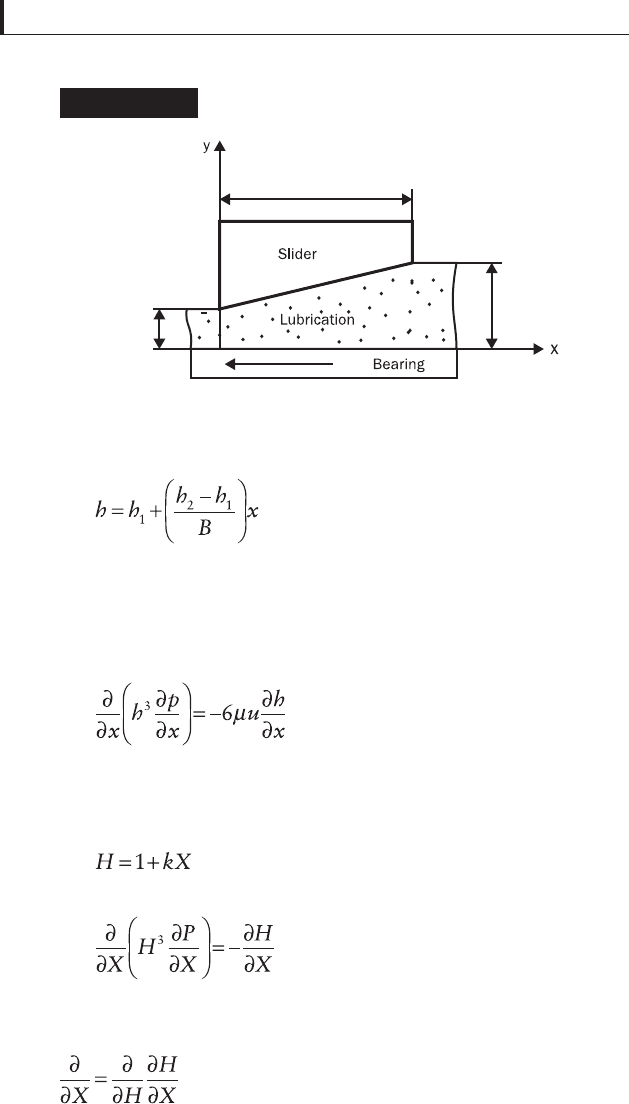
76
Tribology for Engineers
The fi lm thickness (h) has a linear taper codirectional with
the surface velocity u
[3.12]
Note that the exit fi lm thickness h
2
is unknown and should be
determined as part of the bearing design. The bearing taper
(h
1
-h
2
) is also a design parameter (determined via analysis).
Reynolds’ equation for this 1D case has the form
[3.13]
Transformation of eqs. [3.12] and [3.13] with X = x/L, H =
h/h
1
, P = ph
2
1
/(6
μ
uL), k = (h
2
–h
1
)/h
1
leads to the dimensionless
expressions
[3.14]
and
[3.15]
Substituting the derivative of the thickness and passing
to those with respect to H according to the chain rule
, we obtain
L
h
1
h
2
u
Slider geometry and coordinates
Figure 3.3

77
Lubrication and roughness
[3.16]
And after double integration with respect to H
[3.17]
The constants of integration should be determined from the
boundary conditions P = 0 at both X = 0 and X = 1 (no
hydrodynamic pressure outside the slider wedge). Applying
this to eq. [3.15], we obtain C
1
= –2(1 + k)/[k(2 + k)] and
C
2
= –1/[k(2 + k)]. Thus
[3.18]
The hydrodynamic pressures for several p calculated by
eq. [3.18] are presented in Fig. 3.4 for several slider inlet/
outlet ratios H
2
/H
1
= k + 1. Increase of the maximal pressure
H
2
/H
1
= 1.5
H
2
/H
1
= 2
H
2
/H
1
= 3
H
2
/H
1
= 4
Dimensionless pressure and inlet-to-outlet ratio
Figure 3.4
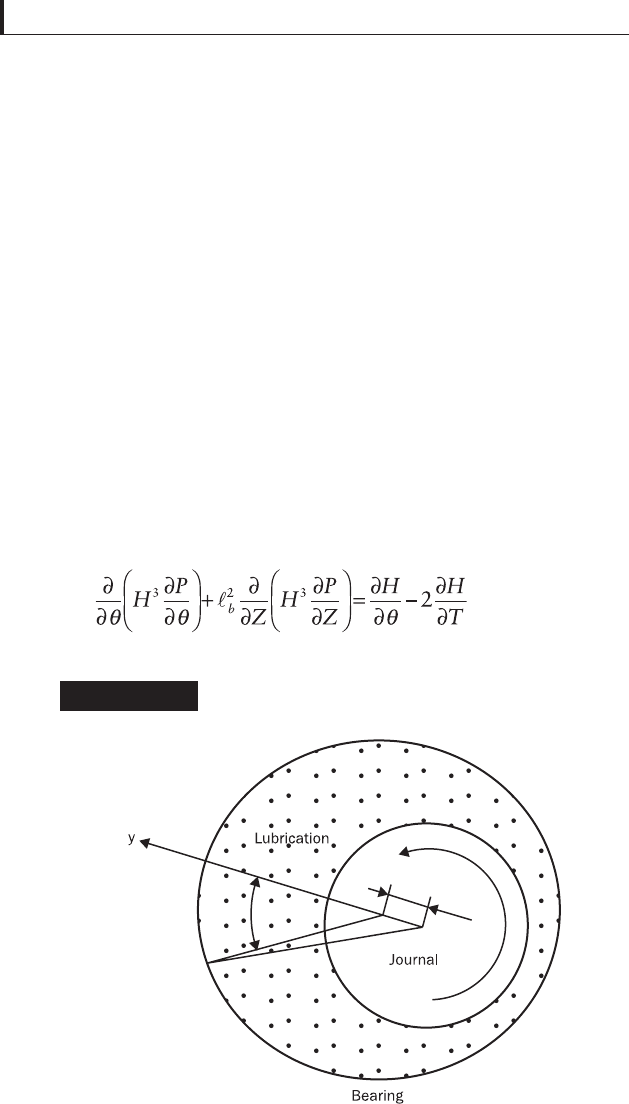
78
Tribology for Engineers
with the ratio H
2
/H
1
occurs at small wedge angles (ratio less
than 2.2), above which it drops – see curve for H
2
/H
1
= 4.
3.5.2 Cylindrical journal bearings
Cylindrical journal bearings are common in rotating
machinery such as generators, motors, compressors, turbines,
etc. This bearing comprises of an inner rotating cylinder
(journal) of radius R and an outer immobile cylinder
(bearing) of radius R
b
> R. The geometry and coordinate
system are shown in Fig. 3.5.
In most fl uid-fi lm bearings with incompressible liquid
lubricant, the radial clearance ratio (R
b
– R)/R
b
is typically
0.001. When x = R
θ
, z = ZL, t = TR/u, h = Hc, and P = pc
2
/
(6
μ
uR), Reynolds’ equation [3.9] can be rewritten in
dimensionless form as:
[3.19]
h
R
Rq
e
w
q
Cylindrical journal bearing geometry and
coordinate system
Figure 3.5
